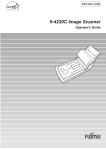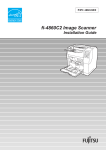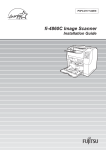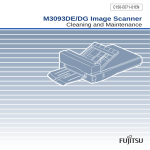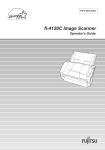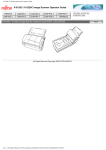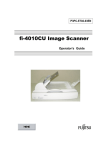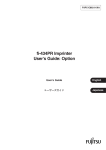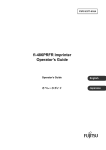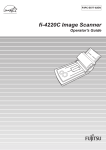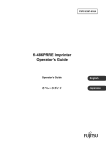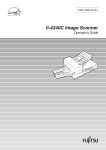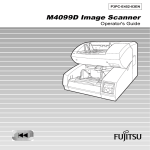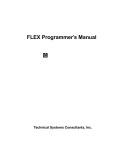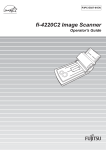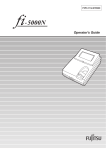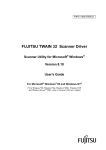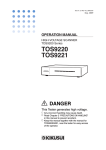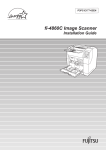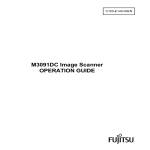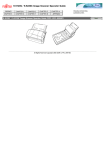Download fi-4120C Image Scanner Operator`s Guide
Transcript
P3PC-E007-01EN fi-4120C Image Scanner Operator's Guide INTRODUCTION Thank you for buying the fi-4120C Duplex Color Scanner. The fi-4120C scanner is capable of scanning color images on both sides, and has the following features. ■ Easy Scanning and Display The ADF (Automatic Document Feeder) allows you to scan A4-size duplex color documents at a high speed of 25 pages per minute. ■ Easily Installable The scanner's size smaller than A4, it can always place on a desk. i About this manual How This Manual Is Organized This manual is organized as follows. An index is provided at the end of this manual. 1 PREPARING THE SCANNER This chapter describes how to prepare the scanner for use. 2 INSTALLATION OF A SCANNER This chapter describes how to install and connect the scanner, and how to install the scanner application. 3 BASIC SCANNER OPERATIONS This chapter describes basic scanner operations. 4 SCANNING VARIOUS TYPES OF DOCUMENTS This chapter describes how to scan various types of documents. 5 DAILY CARE This chapter describes how to clean the scanner. 6 REPLACING CONSUMABLES This chapter describes how to replace scanner consumables. 7 TROUBLESHOOTING This chapter describes how to remedy document jams, other trouble, items to check before contacting the agent where you bought the scanner, and how to check device labels. ii 8 ADF AND PAPER SPECIFICATION This chapter describes the required document size and paper quality for ensuring correct operation of the ADF. 9 SCANNER SPECIFICATION This chapter lists the scanner specifications. We hope that this manual is useful in taking full advantage of the fi-4120C Duplex Color Scanner's advantages. April, 2002 iii Revisions FCC declaration This equipment has been tested and found to comply with the limits for a Class B digital device, pursuant to Part 15 of the FCC Rules. These limits are designed to provide reasonable protection against harmful interference in a residential installation. This equipment generates, uses, and can radiate radio frequency energy and, if not installed and used in accordance with the instruction manual, may cause harmful interference to radio communications. However, there is no guarantee that interference will not occur in a particular installation. If this equipment does cause harmful interference to radio or television reception, which can be determined by turning the equipment off and on, the user is encouraged to try to correct the interference by one or more of the following measures: iv • Reorient or relocate the receiving antenna. • Increase the separation between the equipment and receiver. • Connect the equipment into an outlet on a circuit different from that to which the receiver is connected. • Consult the dealer or an experienced radio/TV technician for help. WARNING NOTICE Changes or modifications not expressly approved by the party responsible for compliance could void the user’s authority to operate the equipment. • The use of a non-shielded interface cable with the referenced device is prohibited. The length of the parallel interface cable must be 3 meters (10 feet) or less. The length of the serial interface cable must be 15 meters (50 feet) or less. • The length of the AC cable must be 3 meters (10 feet) or less. This Class B digital apparatus complies with Canadian ICES-003. Cet appareil numérique de la classe B est conformme à la norme NMB-003 du Canada. v Bescheimigung des Herstellers / Importeurs Hiermit wird bescheinigt, daß der/dieldas vi • fi-4120C in Übereinsstimmung mit den Bestimmungen der • AmtsblVfg 243/1991 funkentstört ist. Der Deutschen Bundesport wurde das Inverkehrbringen dieses Gerätes angezeigt und die Berechtigung zur Überprüfung der Serie auf Einhaltung der Bestimmungen eingeräumt. • Maschinenlärminformationsverordnung 3. GS GV, 18.01.1991:Der höchste Schalldruckpegel beträgt 70 dB (A) order weniger gemäß ISO/7779. International Energy Star Program As a participating operator of the International Energy Star Program, PFU LIMITED. certifies that this product satisfies the requirements of the International Energy Star Program. The International Energy Star Program is an international program for promoting energy conservation in computers and other office equipment. The purpose of this program is to promote the development and propagation of products provided with functions for efficiently limiting energy consumption. Operators opt to participate in this program on a voluntary basis. Equipment covered by this program are computers, displays, printers, facsimiles, copiers, and other office equipment. The standards for each of these equipment Energy Star mark ( each participating country. ) are unified by Use in High-safety Applications This product has been designed and manufactured on the assumption that it will be used in office, personal, domestic, regular industrial, and general-purpose applications. It has not been designed and manufactured for use in applications (simply called "high-safety applications" from here on) that directly involve serious danger to life and health when an extremely high degree of safety is required, for example, in the control of nuclear reactions at nuclear power facilities, automatic flight control of aircraft, air traffic control, operation control in mass-transport systems, medical equipment for sustaining life, and missile firing control in weapons systems, and when provisionally the safety in question is not ensured. The user should use this product without adopting measures for ensuring safety in such high-safety applications. FPU Co., Ltd. assumes no liability whatsoever for damages arising from use of this product by the user in high-safety applications, and for any claims or compensation for damages by the user or a third party. vii About the use of mercury Scanner lamp includes mercury. Too avoid unexpected injury, read the followings carefully. Doing following actions may result in serious personal injuries: • Put the substance in the lamp into mouth as it contains mercury. • Vaporize, crumb, condense the scanner. • Aspirate the chemical liquid containd in scanner parts. Dispose of the scanner should be conducted as required by local ordinances or regulations. Illegal Copying Copying of bank notes, currency, government-issued bonds and passports, licenses and permits issued by public and private organizations, official documents, private documents, etc. is illegal and punishable by law. Copyright Copyright items such as books, paintings, wood block prints, maps, drawings, photographs, etc. cannot be reproduced without the permission of the rightful person except in individual or domestic applications, or in other similar applications within a limited scope. viii Trademarks Microsoft®, Windows® and Windows NT® are registered trademarks of Microsoft Corporation of the USA and other respective countries. ISIS® is a registered trademark of Pixel Translations, A Division of Actionpoint Inc. Adobe and the Adobe logo as well as Acrobat and the Acrobat Logo are trademarks of Adobe Systems Incorporated. Other product names referred to in this manual are registered trademarks or trademarks of respective companies. How Trademarks Are Indicated In This Manual References to operating systems (OS) are indicated as follows: Windows® 95: Refers to Microsoft® Windows® 98 operating system. Windows® 98: Refers to Microsoft® Windows® 98 operating system. Windows® Me: Refers to Refers to Microsoft® Windows® Millennium Edition operating system. Windows® 2000: Refers to Microsoft® Windows® 2000 Professional operating system. Windows® XP: Refers to Microsoft® Windows® XP Professional operating system, and Microsoft® Windows® XP Home Edition operating system Windows NT®: Refers to Microsoft® Windows NT® operating system Version4.0. Where there is no distinction between the different versions of the above operating system, the general term "Windows® " is used. All Rights Reserved, Copyright© PFU LIMITED 2002. ix Preface Safety Precautions This manual describes important details for ensuring the safe and correct use of this product. Thoroughly read this manual before you start to use this product. In particular, be sure to read and fully understand the Safety Precautions described in this manual before you use this product. Also, store this manual in a safe place so that it can be easily referred to during use of this product. Warning Indications Used In This Manual This manual uses the following indications to ensure safe and correct use of this product, and to prevent possible danger and injury to the operator and other persons. WARNING CAUTION x This indication alerts operators to an operation that, if not strictly observed, may result in severe injury or death. This indication alerts operators to an operation that, if not strictly observed, may result in safety hazards to personnel or damage to equipment. Symbols Used In This Manual This manual uses the following symbols in explanations in addition to warning indications. ATTENTION HINT This symbol alerts operators to particularly important information. Be sure to read this information. This symbol alerts operators to helpful advice regarding operation. A TRIANGLE symbol indicates that special care and attention is required. The drawing inside the triangle shows the specific caution. A CIRCLE with a diagonal line inside shows action which users are not allowed to do.The drawing inside or under the circle shows the specific action that is not allowed. Outline characters on a colored background shows instructions users should follow. It may include the drawing which shows the sepecific instruction. xi Screen Examples In This Manual The screen examples in this manual are subject to change without notice in the interest of product improvement. If the actual displayed screen differs from the screen examples in this manual, operate by following the actual displayed screen referring to the User's Manual of the scanner application you are using. Furthermore, the screenshots in this manual are for the FUJITSU TWAIN32 scanner driver and the Image Capturing Software Utilities "ScandAll 21" for Microsoft® Windows®. xii Safety Precautions WARNING The following describes important warnings described in this manual. Do not damage the AC cable. A damaged AC cable might cause fire or electric shock. Do not place heavy objects on AC cables, or pull, bend, twist, heat, damage or modify AC cables. Also, do not use damaged AC cables or power plugs, and AC cables or power plugs when the power outlet fitting is loose. Use only specified AC cables and connector cables Use only specified AC cables and connector cables. Failure to use the included so might cause electric shock and equipment failure. xiii Use this scanner only at the indicated power voltage. Do not connect to multiple-power strips. Use this scanner only at the indicated power voltage. Improper power voltage so might cause fire or electric shock. Also, do not connect to multiple-power strips. Wipe any dust from the power plug. Wipe off any dust from metal parts on the power plug or metal fittings with a soft, dry cloth. Accumulated dust might cause fire or electric shock. Do not install in locations subject to oil smoke, steam, humidity, and dust. Do not install the scanner in locations subject to oil smoke, steam, humidity, and dust. Doing so might cause fire or electric shock. xiv Do not use the scanner if you smell strange odor. If you sense heat coming from devices or detect other malfunctions such as smoke, strange smells or strange noises, immediately press down the power button to turn off the scanner and then disconnect its power plug. Make sure that the smoke has disappeared, and then contact the agent where you bought the scanner. Turn the scanner OFF if it is damaged. If the scanner is damaged for any reason, press down the power button the scanner and unplug the power cable before contacting the authorized agent. xv Do not allow liquids to get inside the scanner. Do not insert or drop foreign metal objects in to the scanner. Do not scan wet document or document with paper clips. Do not splash or allow the scanner to get wet. If foreign objects (water, small metal objects, liquids, etc.) get inside the scanner, immediately press down the power button to turn off the scanner and disconnect the power plug from the power outlet. Then contact the agent where you bought the scanner or Maintenance Service Center. Pay particular attention to this warning in households where there are small children. xvi Do not touch the inside of the scanner unless necessary. Do not disassemble or modify the scanner. The inside of the scanner contains high-voltage components. Touching these components might cause fire or electric shock. xvii CAUTION The following describes important cautions described in this manual. Do not touch the AC cable with wet hands. Do not insert or disconnect the power plug with wet hands. Doing so might cause electric shock. Do not install the scanner on unstable surfaces. Install the scanner on a desk so that none of its parts protrude outside of the desktop. Also, make sure that the scanner is installed on a flat, level surface. Do not install the scanner on unstable surfaces. Install the scanner on a level surface that is free of vibration to prevent it from tilting. Firmly insert the power plug. Firmly insert the power plug into the power outlet as far it can go. xviii Do not block the ventilation ports. Do not block the ventilation ports. Blocking the ventilation ports generates heat inside of scanner, resulting in fire or scanner failure. Do not place heavy objects or climb on top of the scanner. Do not place heavy objects on the scanner or use the scanner's top surface for performing other work. Improper installation might cause injuries. Before moving the scanner, disconnect the power plug from the power outlet. Do not move the scanner with the power and interface cables connected as this might damage the cables, causing fire, electric shock or injuries. Before moving the scanner, be sure to disconnect the power plug from the power outlet, and disconnect connector cables. Also, make sure that the floor is free of obstructions. xix Protect the scanner from static electricity. Install the scanner away from strong magnetic fields and other sources of noise. Also, protect the scanner from static electricity as this might cause the scanner to malfunction. Do not use aerosol sprays near the scanner. Do not use aerosol sprays, for example, to clean the scanner. Air sprayed from aerosol sprays causes dirt and dust to enter the scanner, resulting scanner failure and malfunction. Avoid any contact when scanner is in use. Avoid any contact when scanner is operating as this may cause injuries. xx Disconnect the power plug from the power outlet when the scanner is not used for a long period of time. When the scanner is not used for a long period of time, be sure to disconnect the power plug from the power outlet for safety's sake. Disconnect the power plug from the power outlet as soon as you hear thunder. If lightning strikes nearby, immediately disconnect the AC cable from the power outlet. Leaving the scanner turned ON might result in damage to the scanner. Do not install the scanner in the direct sunlight. Do not install the scanner in the direct sunlight or near heating apparatus. Doing so might cause heat to build up inside the scanner, causing fire or scanner trouble. Install the scanner in a wellventilated location. xxi Fujitsu Group Offices Please send your comments on this manual or on Fujitsu products to the following addresses: xxii FUJITSU COMPUTER PRODUCTS OF AMERICA, INC. 2904 Orchard Parkway, San Jose, CA 95134-2009, U.S.A. Phone: (1-800)591-5924; (1-408)432-6333 Technical Assistance Center: (1-800)626-4686 Fax: (1-408)894-1709 Website: http://www.fcpa.com/ E-mail: [email protected] FUJITSU CANADA, INC. 2800 Matheson Boulevard East, Mississauga, Ontario L4W 4X5, Canada Phone: (1-905)602-5454 Fax: (1-905)602-5457 Website: http://www.fujitsu.ca/ E-mail: [email protected] (For Sales Questions) [email protected] (For technical questions) FUJITSU EUROPE LTD. Hayes Park Central, Hayes End Road, Hayes Middlesex UB4 8FE, U.K. Phone: (44-208)573-4444 Fax: (44-208)573-2643 Website: http: //www.fujitsueurope.com/ E-mail: [email protected] FUJITSU DEUTSCHLAND GMBH. Frankfurter Ring 211, 80807 München 40, Germany Phone: (49-89)323-78-0 Fax: (49-89)323-78-100 Website: http://de.fujitsu.com/ E-mail: [email protected] FUJITSU ITALIA S.p.A. Via Nazario Sauro, 38 20099 Sesto San Giovanni (Milan), Italy Phone: (39-02)26294-1 Fax: (39-02)26294-201 Website: http://www.fujitsu-europe.com/ FUJITSU ICL ESPAÑA, S.A. Camino Cerro de los Gamos, 1 28224, Pozuelo de Alarcon, Madrid, Spain Phone: (34-91)784-9000 Fax: (34-91)784-9379 Website: http://www.fujitsu-europe.com/ E-mail: [email protected] FUJITSU AUSTRALIA LTD. Fujitsu House 2 Julius Avenue North Ryde, N.S.W 2113 Australia Phone: (61-2)9776-4555 Fax: (61-2)9776-4019 Website: http://au.fujitsu.com/ FUJITSU ASIA PTE.LTD. 20 Science Park Road, #03-01, Tele Teck Park Singapore Science Park II, Singapore 117674 Phone: (65)777-6577 Fax: (65)771-5499 Website: http://sg.fujitsu.com/ E-mail: [email protected] FUJITSU TAIWAN LTD. 19th Fl., No39, Sec.1,Chunghwa Rd., Taipei, Taiwan R.O.C. Phone: (886-2)2311-2255 Fax: (886-2)2311-2277 Website: http://fw.fujitsu.com/ FUJITSU HONG KONG LTD. 10/F., Lincoln House, 979 King's Road, Taikoo Place, Island East, Hong Kong Phone: (852)2827-5780 Fax: (852)2827-4724 Website: http://hk.fujitsu.com/ E-mail: [email protected] xxiii xxiv FUJITSU SYSTEMS BUSINESS (THAILAND) LTD. 12th Fl., Olympia Thai Tower, 444 Rachadapisek Road, Samsennok, Huay kwang, Bangkok 10320, Thailand Phone: (662)512-6066 Fax: (662)512-6068 Website: http://th.fujitsu.com/ FUJITSU KOREA LTD. 5-11 Fl., Coryo Finance Center Building, Youido-Dong 23-6, Young DungPo-gu, Seoul, Korea, 150-010 Phone: (82-2)3787-6159 Fax: (82-2)3787-6164 Website: http://kr.fujitsu.com/ E-mail: [email protected] FUJITSU MALAYSIA SDN.BHD. 7th FL., Wisma Damansara, Jalan Semantan 50490 Kuala Lumpur, MALAYSIA Phone: (60-3)254-3644 Fax: (60-3)253-3940 Website: http://my.fujitsu.com/ FUJITSU PHILIPPINES, INC 2nd Fl., United Life Building, Pasay Road, Legaspi Village Makati, Metro Manila, Philippines Phone: (63-2)812-4002 Fax: (63-2)817-7576 Computer Products Business Group 658-1 Tsuruma Machida-shi, Tokyo 194-8510, Japan Phone: (81-42)796-5211 Fax: (81-42)788-7651 Website: http://www.pfu.fujitsu.com/ E-mail: [email protected] Corporate headquarters Nu 98-2 Unoke, Unoke-machi, kahoku-gun, Ishikawa 929-1192, Japan Phone: (81-76)283-1212 Fax: (81-76)283-4689 CONTENTS 1 PREPARING THE SCANNER ...............1 1.1 Checking the Contents of the Scanner Package ...... 2 1.2 Names and Functions of Parts .................................. 4 1.3 Operator panel .......................................................... 9 2 INSTALLATION OF A SCANNER.......15 2.1 Installing the Scanner .............................................. 16 2.2 Connecting the Scanner to a PC ............................. 19 2.3 Installing the Scanner Application ........................... 26 3 BASIC SCANNER OPERATIONS.......27 3.1 Turning the Scanner ON ......................................... 28 3.2 Loading Documents on the ADF for Scanning ........ 30 3.3 Scanning Documents .............................................. 36 4 SCANNING VARIOUS TYPES OF DOCUMENTS ......................................41 4.1 Scanning Different-width Documents ...................... 42 4.2 Saving Scanned Images in PDF Format ................. 43 4.3 Excluding a Color in the Image(dropout color) ........ 48 4.4 Detecting Double-feeds ........................................... 51 5 DAILY CARE........................................55 5.1 Cleaning Materials and Locations and Cleaning Cycle ........................................................ 56 5.2 Cleaning the ADF .................................................... 58 xxv 6 REPLACING CONSUMABLES ...........65 6.1 Consumable and Replacement Cycle ..................... 66 6.2 Replacing the Pad ASY ........................................... 74 6.3 Replacing the Pick Roller ........................................ 80 7 TROUBLESHOOTING .........................91 7.1 Removing Jammed Documents .............................. 92 7.2 Remedying Typical Troubles ................................... 95 7.3 Items to check before contacting the agent where you bought the scanner .............................. 114 7.4 Checking Labels on the Scanner .......................... 118 8 ADF AND PAPER SPECIFICATION .121 8.1 Document Size ...................................................... 122 8.2 Document Quality .................................................. 123 8.3 Maximum Document Loading Capacity ................ 127 8.4 Hole-punching Prohibited Areas ........................... 128 8.5 Double-feed Detection Conditions ........................ 129 9 SCANNER SPECIFICATION .............133 9.1 Basic Specifications .............................................. 134 9.2 Installation Specifications ...................................... 136 9.3 External Dimensions ............................................. 138 GLOSSARY OF TERMS .....................GL-1 INDEX ................................................... IN-1 xxvi 1 PREPARING THE SCANNER 1 PREPARING THE SCANNER This chapter describes how to prepare the scanner for use. 1.1 Checking the Contents of the Scanner Package ....... 2 1.2 Names and Functions of Parts .................................... 4 1.3 Operator panel .............................................................. 9 1 1.1 Checking the Contents of the Scanner Package When you unpack the scanner package, make sure that all the following parts are included in the package. If any parts are missing or defective, contact your sales representative. Handle the scanner and accessories with care. 2 1.1 Checking the Contents of the Scanner Package Scanner and Accessories • Scanner • ADF paper chute • AC adapter • AC cable 1 USB interface cable • Scanner driver CD-ROM • Adobe® Acrobat® 5.0 CD-ROM • Manual CD-ROM • Operator's Guide (this manual) • Quick Installation Guide fi-X XX X XX XX XX XX X 1.1 Checking the Contents of the Scanner Package 3 PREPARING THE SCANNER • 1.2 Names and Functions of Parts This section describes the names of parts and their functions. ■ Front (2) ADF paper chute (3) Side guide (1) Automatic document feeder (ADF) (4) ADF button (5) Operator panel (6) Stacker 4 1.2 Names and Functions of Parts Name Function 1 ADF(Automatic document feeder) Automatically feeds documents into the scanner. 2 ADF paper chute Used when scanning documents on the ADF. 3 Side guide Adjust the side guides to match the width of the document to avoid image skew. 4 ADF button Press this button to open the ADF cover, for example, to remove jammed documents in the ADF. 5 Operator panel Used for operating the scanner. The scanner status is shown on the Function No. display. 6 Stacker Documents are stacked here after they are scanned. 1.2 Names and Functions of Parts 5 1 PREPARING THE SCANNER No. ■ Rear (7) SCSI ID switch (8) SCSI Interface connector 6 1.2 Names and Functions of Parts (10) DC inlet (9) USB Interface connector No. Name Function 7 SCSI ID switch Sets the SCSI ID. (Set to "5" before the scanner is shipped from the factory.) 8 SCSI interface connector Connect the SCSI interface cable from the host PC or Computer here. 9 USB interface connector Connect the USB interface cable from the host PC or Computer here. 10 DC inlet Connect the AC adapter here. PREPARING THE SCANNER 1.2 Names and Functions of Parts 1 7 ■ Removable Parts The following shows the parts that can be removed from the scanner. Sheet guide ADF paper chute PAD ASY Pick roller Removal is possible. 8 1.2 Names and Functions of Parts 1.3 Operator panel The operator panel is located on the right side of the scanner. This panel comprises a Function No. display, four buttons and a LED. 1 PREPARING THE SCANNER Function No. display Function Send to Scan Power button LED 1.3 Operator panel 9 Name Function Function No. display Indicates the function No., Scan mode, and error status. For details, see "■ Indications on the Function No. display" in this section. button Function Select the Function No. set in the launcher (*). Send to Scan Start and read the application software according to the details set in the launcher (*). Power button Turns the scanner ON and OFF. - Lights when the scanner is turned ON. LED *) For information on detailed settings for the launcher, refer to the Scanner Utility for Microsoft® Windows® User’s Guide on the scanner driver CD-ROM. 10 1.3 Operator panel ■ Indications on the Function No. display The following shows the indications on the Function No. display. ■P Indicates that the scanner has been turned ON and is being initialized. ■0 ■1 Indicates that initialization has ended successfully. Also, this status is called "Ready Status". ■U Indicates that a temporary error occurred while the document was being scanned. "U" and "1 and 2" are display alternately. To return the scanner to the ready status ("1"), press "Scan" or "Send to" button while the error is indicated. 1.3 Operator panel 11 PREPARING THE SCANNER Indicates that initialization will soon end. 1 ■E Indicates that a device alarm occurred while the document was being scanned. "E" and the alarm No. (2 to 9, c and d) are indicated alternately. To return the scanner to the ready status ("1"), press "Scan" or "Send to" button while the alarm is indicated. If this alarm occurs, turn the power off and on again. If the alarm continues after turning on the power again, contact your service engineer. 12 1.3 Operator panel The following table shows the details of each temporary error. Indication Meaning U1 Paper feed error occurs. U2 Double feed error occurs. 1 The following shows the procedure for releasing of each temporary error. "U1" error If this error occurs, remove jammed document. See "7.1 Removing Jammed Documents" for removing jammed document. • "U2" error If this error occurs, remove the jammed documents. See "7.1 Removing Jammed Documents" for removing the jammed documents. Confirm the documents meet paper condition for ADF scanning. See "■ Precautions" in "8.2 Document Quality" for document conditions. 1.3 Operator panel 13 PREPARING THE SCANNER • The following table shows the details of alarms. Indication 14 Meaning E2 An trouble occurred on the optical system (front). E3 An trouble occurred on the optical system (back). E4 The motor fuse has blown. E6 An trouble occurred on the operator panel. E7 An trouble occurred in the EEPROM. E8 The SCSI interface fuse has blown. E9 An trouble occurred in image memory. Ec An trouble occurred in memory. Ed An trouble occurred in the SCSI interface controller. 1.3 Operator panel 2 INSTALLATION OF A SCANNER This chapter describes how to install and connect the scanner, and how to install the scanner application. Refers to Microsoft® Windows® 95 operating system. Windows® 98 Refers to Microsoft® Windows® 98 operating system. Windows® Me Refers to Microsoft® Windows® Millennium Edition operating system. Windows® 2000Refers to Microsoft® Windows® 2000 Professional operating system. Windows® XP Refers to Microsoft® Windows® XP Professional operating system. Refers to Microsoft® Windows® XP Home Edition operating system. Windows NT® Refers to Microsoft® Windows NT® operating system Version4.0. 2.1 Installing the Scanner ................................................ 16 2.2 Connecting the Scanner to a PC ............................... 19 2.3 Installing the Scanner Application............................ 26 15 INSTALLATION OF A SCANNER Windows® 95 2 2.1 Installing the Scanner The following shows the procedure for installing the scanner. 1. Place the scanner at its installation site. For details on the scanner's dimensions and required installation space, see "9.2 Installation Specifications." 2. Attach the ADF paper chute. For details on how to attach the ADF paper chute, see "■ Attaching the ADF paper chute" in this section. 3. Connect the AC adapter. For details on how to connect the AC adapter, see "■ Connecting the AC Adapter" in this section. 16 2.1 Installing the Scanner ■ Attaching the ADF paper chute The following shows the procedure for attaching the ADF paper chute. 1. Hold the ADF paper chute and insert its tabs into the counterpart holes on the scanner as shown in the figure below. The Side guide of the ADF paper chute has to face up. 2 ADF paper chute INSTALLATION OF A SCANNER tab Side guide 2.1 Installing the Scanner 17 ■ Connecting the AC Adapter The following shows the procedure for connecting the AC adapter. CAUTION 18 Use only whth AC adapter provided by the manufacturer. 1. Connect the AC cable to the AC adapter. 2. Connect the connector of AC adapter to the DC inlet of the scanner. 3. Insert the AC cable into the outlet. 2.1 Installing the Scanner 2.2 Connecting the Scanner to a PC When running Windows® 95 or Windows NT® 4.0, connect the SCSI interface cable. When running Windows® 98, Windows® ME, Windows® 2000, or Windows® XP, connect either the USB interface cable or the SCSI interface cable. 2.2 Connecting the Scanner to a PC 19 INSTALLATION OF A SCANNER ATTENTION Connect only one of the USB or SCSI interface cables. Windows® 95 and Windows NT® 4.0 does not support USB interface. 2 ■ Connecting the USB Interface Cable The following shows the procedure for connecting the USB interface cable. 20 1. Connect the USB interface cable to the USB interface connector. 2. Connect the other end of the USB interface cable to the PC. 3. Press down the scanner power button on the Function No. display to turn on the scanner. 2.2 Connecting the Scanner to a PC 4. Press the power button on the face plate of the PC to turn on the PC. Be sure to use the USB cable which comes as an accessory with this scanner. We does not confirm the correct operation of a commercial USB cable. • When connecting to a USB hub, use the first stage USB hub that is closest to the computer. If you use the second or later, the scanner may not operate correctly. • This scanner is provided with two interfaces: SCSI-2 and USB1.1. On this scanner, each of the SCSI and USB interfaces is controlled exclusively, so both interfaces cannot be used simultaneously. Scanner can be only connected to either USB or SCSI interface. ATTENTION 2.2 Connecting the Scanner to a PC 21 2 INSTALLATION OF A SCANNER • ■ Connecting the SCSI Interface Cable When using the scanner with SCSI interface, a third-party SCSI interface cable and SCSI card must be present. • SCSI interface cable The physical specifications of connector is complied with SCSI-2.The 50 Pin Contact Shielded High-Density SCSI Device Connector is used. • SCSI card The recommended SCSI card is noted on the following home page. http://imagescanner.fujitsu.com/ • When connecting the SCSI interface cable, be sure to first connect the SCSI interface cable then turn on the power of the scanner and the personal computer. • Connect the scanner so that it is the terminal device on the SCSI daisy chain. • The SCSI card and SCSI interface cable has to be purchased separately. ATTENTION 22 2.2 Connecting the Scanner to a PC The following shows the procedure for connecting the SCSI interface cable. 1. Insert the SCSI interface cable into the interface connector until both sides click. 2 Connect the connector on the other end of the cable to the personal computer. ATTENTION When using the scanner on the SCSI interface, connect the scanner so that it is the terminal device on the SCSI daisy chain. 2.2 Connecting the Scanner to a PC 23 INSTALLATION OF A SCANNER 2. HINT 3. Press down the scanner power button on the Function No. display to turn on the scanner. 4. Press the power button on the face plate of the PC to turn on the PC. ATTENTION 24 The factory default setting for SCSI ID is "ID 5". If the SCSI ID of another SCSI device is set to the same ID, either change the scanner's SCSI ID or change the SCSI ID of the other SCSI device. For details on how to change the SCSI ID, see "■ Setting the SCSI ID" in this section. This scanner is provided with two interfaces: SCSI-2 and USB1.1. On this scanner, each of the SCSI and USB interfaces is controlled exclusively, so both interfaces cannot be used simultaneously. Scanner can be only connected to either USB or SCSI interface. 2.2 Connecting the Scanner to a PC ■ Setting the SCSI ID The factory default setting for SCSI ID is "ID 5". The following shows the procedure for setting (changing) the SCSI ID. 1. If the scanner is ON, press the power button to turn the scanner OFF. Disconnect the AC cable from the outlet. 2. Set the device address using the SCSI ID switch on the back of the image scanner. 23 3. 901 ID No. 78 Click Description 0 to7 These address numbers can be set. 8, 9 The factory default value (SCSI ID = 5) is used for these numbers. Press the power button to turn the scanner ON. When the scanner is turned ON, the SCSI ID set in step 2. is enabled. After setting the address number corresponding to the target SCSI ID, connect the AC cable to the outlet and turn on the scanner. 2.2 Connecting the Scanner to a PC 25 INSTALLATION OF A SCANNER 456 2 2.3 Installing the Scanner Application To enable scanning of documents on the scanner, the Scanner driver (FUJITSU TWAIN32 scanner driver) and Image Capturing Software Utilities “ScandAll 21” for Microsoft® Windows® (ScandAll 21) must be installed on your PC. For details on installing the FUJITSU TWAIN32 scanner driver and Image Capturing Software Utilities “ScandAll 21” for Microsoft® Windows® (ScandAll 21) , refer to the fi-4220C Quick Installation Guide. For further details on installing the FUJITSU TWAIN32 scanner driver, refer to the Scanner Utility for Microsoft® Windows® User’s Guide on the scanner driver CD-ROM. • The scanner driver needs to be installed prior to scanner application. • You must install the scanner driver and all software components in order to use the Function No. display of the image scanner. ATTENTION 26 2.3 Installing the Scanner Application 3 BASIC SCANNER OPERATIONS This chapter describes basic scanner operations. 3.1 Turning the Scanner ON............................................. 28 3.2 Loading Documents on the ADF for Scanning ........ 30 3.3 Scanning Documents ................................................. 36 27 3 BASIC SCANNER OPERATIONS This chapter explains samples of the screens in Windows® XP. The screens and operations may differ slightly if the OS that you are using is other than Windows® XP. Also, when FUJITSU TWAIN32 is updated the screens and operations noted in this chapter will differ slightly. 3.1 Turning the Scanner ON This section describes how to turn the scanner ON. The following shows the procedure for turning the scanner ON. 1. Press the power button on the operator panel. The scanner is turned ON, and the green LED on the operator panel lights. Also, while the scanner is being initialized, the indication of the Function No. display changes as follows: “8”->"P" -> "0" -> "1" The "1" status on the operator panel is ready status. Power button HINT 28 To turn the scanner OFF, hold the power button down for two seconds. 3.1 Turning the Scanner ON ■ Power Save Mode The Power Save mode keeps the scanner in a low-powered state after it has been turned ON. If no operation is performed on the scanner for 15 minutes, the scanner automatically switches to the Power Save mode. In the Power Save mode, the indication of the Function No. display on the operator panel goes out, but the green LED stays lit. To return from the Power Save mode, perform one of the following: • Load the document on the ADF paper chute. • Press any button on the operator panel. However, holding down the power button for will turn the scanner OFF. • Execute a command from the scanner driver. 3 BASIC SCANNER OPERATIONS 3.1 Turning the Scanner ON 29 3.2 Loading Documents on the ADF for Scanning The following shows the procedure for loading documents on the ADF paper chute. 1. Align the edges of the document. To do this, perform the following. 1) Align the front and side edges of the document to be loaded. Documents can be scanned more correctly if both edges are aligned. 2) Check the number of sheets in the document. The standard number of sheets that can be loaded on the scanner is as follows: • Number of sheets of A4-size paper or smaller that makes a document stack of 5mm or less • Maximum 50 sheet at A4, 20 lb, or 80g/m2 30 3.2 Loading Documents on the ADF for Scanning 2. Fan the document When loading a multiple-sheet document, fan the document as follows. 1) Take out a stack of document sheets with thickness of 5mm or less. 2) Lightly grip both ends of the document with both hands, and bend the document as follows. 5mm 3 4) Repeat steps 1) to 3) a few times. 5) Rotate the document 90 degrees, and fan again. 3.2 Loading Documents on the ADF for Scanning 31 BASIC SCANNER OPERATIONS 3) Firmly holding the document with both hands, bend back the document as follows so that the bent section rises up in the middle of the document as follows. 3. Load the document on the ADF paper chute. Set the document so that the front side of the document (side to be scanned as first page) contacts to the ADF paper chute. Furthermore, when you have multiple pages, set the document so that the first page is on the same side as the ADF paper chute. A Load the document with its front side facing the ADF paper chute.(face down) 32 3.2 Loading Documents on the ADF for Scanning HINT Before loading A4-size documents, pull out the ADF paper chute extension. Extension 4. Move the side guides to eliminate gaps between the side guides and the document. If there are gaps between the side guides and the document, the document is sometimes scanned in skewed. Side guide 3.2 Loading Documents on the ADF for Scanning 33 3 BASIC SCANNER OPERATIONS Move the side guides until they match the width of the document. HINT The stacker prevents document sheets from dropping after they are scanned. Use the stacker as follows: 1. Lift up the stacker towards you by inserting your fingertips into the handle on the scanner. handle 2. Lift the paper stop and swing forward by inserting your fingertips into the indentations on the scanner as shown in below figure. Indentation 34 3.2 Loading Documents on the ADF for Scanning 5. Start up the scanner application, and scan the document. For details on how to scan documents using the ScandAll 21 application, see "3.3 Scanning Documents." 3 BASIC SCANNER OPERATIONS 3.2 Loading Documents on the ADF for Scanning 35 3.3 Scanning Documents The following shows the procedure for scanning documents with the ScandAll 21 scanner application (simply called "ScandAll 21" from here on). 1. Load the document on the scanner's ADF paper chute. For details on how to load documents, see "3.2 Loading Documents on the ADF for Scanning." 2. Start up ScandAll 21. Select [Program] - [Scanner Utility for Microsoft Windows] [ScandAll 21] in that order from the [Start] menu. This starts up ScandAll 21. 3. Select the scanner to be used. Select [Select Source] from the [Scan] menu. 36 3.3 Scanning Documents The [Select Source] dialog box appears. Select "FUJITSU fi-4120Cdj" (Windows® 95 and WindowsNT® 4.0, select “FUJITSU TWAIN 32”) and click the [Select] button. 4. Click the "display in scan preview screen" on the tool bar. 5. Set the scan resolution, paper size and other scan conditions, and click the [Scan] button. For details on settings in the [TWAIN Driver] dialog box, refer to the Scanner Utility for Microsoft® Windows® User’s Guide on the scanner driver CD-ROM. 3.3 Scanning Documents 37 BASIC SCANNER OPERATIONS The [TWAIN Driver] dialog box (screen for setting the scan conditions) appears. 3 38 3.3 Scanning Documents The document is scanned, and an image of the scanned document appears on the ScandAll 21 screen. 3 3.3 Scanning Documents 39 BASIC SCANNER OPERATIONS For details on scanning various other documents, see "Chapter4, SCANNING VARIOUS TYPES OF DOCUMENTS." For details on ScanAll 21 functions and operations, refer to ScandAll 21 Help. 40 3.3 Scanning Documents 4 SCANNING VARIOUS TYPES OF DOCUMENTS This chapter describes how to scan various types of documents. This chapter explains samples of the screens in Windows® XP. The screens and operations may differ slightly if the OS that you are using is other than Windows® XP. Also, when FUJITSU TWAIN32 is updated the screens and operations noted in this chapter will differ slightly. 4.2 Saving Scanned Images in PDF Format ................... 43 4.3 Excluding a Color in the Image(dropout color) ....... 48 4.4 Detecting Double-feeds.............................................. 51 41 SCANNING VARIOUS TYPES OF DOCUMENTS 4.1 Scanning Different-width Documents....................... 42 4 4.1 Scanning Different-width Documents When scanning different-width documents together on the ADF, smaller-width documents sometimes are scanned in skewed. Be sure to scan only documents having the same width. The following shows the procedure for reading the manuscript with which width is different. 1. Sorted to the stack of the same width. 2. Side guide unites with the width of documents. 3. Scan the same-width documents separately. For details on how to load documents, see "3.3 Scanning Documents." 42 4.1 Scanning Different-width Documents 4.2 Saving Scanned Images in PDF Format To save scanned images in PDF format, first install Adobe Acrobat5.0 or later on the PC you are using. Adobe Acrobat5.0 can be installed from the Adobe Acrobat5.0 CDROM provided. The following shows the procedure for saving scanned images in PDF format. 1. Load the document on the ADF paper chute. 2. Start up Adobe Acrobat5.0. Select [Program] - [Adobe Acrobat5.0] in that order from the [Start] menu. This starts up Adobe Acrobat5.0. 4 SCANNING VARIOUS TYPES OF DOCUMENTS 4.2 Saving Scanned Images in PDF Format 43 3. Select [Import] - [Scan...] in that order from the [File] menu. The [Acrobat Scan Plug-in] dialog box appears. 44 4.2 Saving Scanned Images in PDF Format 4. Select "FUJITSU fi-4120Cdj"(Windows® 95 and WindowsNT® 4.0, select “FUJITSU TWAIN 32”) at "Device" and click the [Scan] button. The [TWAIN Driver] dialog box appears. ATTENTION Also select "Simplex" when scanning double-sided documents. 4 SCANNING VARIOUS TYPES OF DOCUMENTS 4.2 Saving Scanned Images in PDF Format 45 5. Set the scan resolution, paper size and other scan conditions, and click the [Scan] button. Scanning starts, and a message for selecting whether or not to continue scanning appears. 46 4.2 Saving Scanned Images in PDF Format 6. To end scanning, click the [Done] button. The scanned image appears. Save the scanned image on Adobe Acrobat5.0. 4 For details on Adobe Acrobat5.0 operations, refer to the Adobe Acrobat5.0 manual and Help. SCANNING VARIOUS TYPES OF DOCUMENTS 4.2 Saving Scanned Images in PDF Format 47 4.3 Excluding a Color in the Image(dropout color) A selected color information (primary colors: red, green or blue) can be excluded (dropped out) from the images when they are scanned. For example, if the document contains black text enclosed by a green frame, you can set the scanner to scan only black areas in the document (i.e. the color green is "dropped out"). To set the scanner to scan documents with a selected color dropped out, change the settings in the [TWAIN Driver] dialog box. The following shows the procedure for changing the settings in this dialog box. 48 4.3 Excluding a Color in the Image(dropout color) 1. Click the [Advance...] button in the [TWAIN Driver] dialog box. 4 2. Select the color to drop out from "Dropout Color" under "More". 4.3 Excluding a Color in the Image(dropout color) 49 SCANNING VARIOUS TYPES OF DOCUMENTS The [Advance] dialog box appears. 3. For example, to scan only black text areas when scanning black text surrounded by a green frame, select [Green]. 4. Click the [OK] button. The [TWAIN Driver] dialog box will be redisplayed. Continue scanning from this dialog box. 50 4.3 Excluding a Color in the Image(dropout color) 4.4 Detecting Double-feeds "Double-feed" is a feeding error that occurs when two or more sheets in the ADF paper chute are fed simultaneously into the scanner. You can set the scanner to detect double-feed, stop scanner operation, and display an error message. To set the scanner to detect double-feed, change the settings in the [TWAIN Driver] dialog box. The following shows the procedure for changing the settings in this dialog box. 4 SCANNING VARIOUS TYPES OF DOCUMENTS 4.4 Detecting Double-feeds 51 1. Click the [Option...] button in the [TWAIN Driver] dialog box. The [Option] dialog box appears. 2. 52 Click the [Option] tab. 4.4 Detecting Double-feeds 3. Select the detection conditions from "Double Feed" under "ADF Option". 4 The following detection conditions are provided: : Double-feed detection is not performed Check thickness : The scanner uses a sensor to monitor the thickness of documents that are fed. It detects a double-feed by differences in document thickness when two or more document sheets are fed overlapping. 4.4 Detecting Double-feeds 53 SCANNING VARIOUS TYPES OF DOCUMENTS None Check length : The scanner uses a sensor to monitor the length of documents that are fed. It detects a double-feed by changes in the document length when two or more document sheets are fed overlapping. Check thickness and length : The scanner monitors both document thickness and length to detect doublefeed. Furthermore, see "8.5 Double-feed Detection Conditions" for detailed information about the document for double-feed detection. 4. Click the [OK] button. The display returns to the [TWAIN Driver] dialog box. Continue scanning from this dialog box. 54 4.4 Detecting Double-feeds 5 DAILY CARE This chapter describes how to clean the scanner. WARNING When cleaning the scanner, turn off the power, and unplug the AC cable from the outlet. 5 DAILY CARE 5.1 Cleaning Materials and Locations and Cleaning Cycle ...................................................................................... 56 5.2 Cleaning the ADF........................................................ 58 55 5.1 Cleaning Materials and Locations and Cleaning Cycle ■ Cleaning Materials The table below shows the cleaning materials that re used on this scanner. Cleaning Materials Cleaner F1 (or isopropyl alcohol) Remarks 1 bottle Moisten cloth with this fluid and wipe the scanner clean. Soft, dry cloth For details on Cleaner F1, consult the agent where you bought your scanner. ■ Locations That Needs To Be Cleaned Same location in the ADF must be cleaned regularly with a soft, dry cloth moistened with Cleaner F1. 56 5.1 Cleaning Materials and Locations and Cleaning Cycle ■ Cleaning Cycle The following table shows the standard cleaning cycle for each location that needs to be cleaned. Location Pad ASY Standard Cleaning Cycle Clean every 1000 scanned sheets. Pick roller Feed roller Plastic roller Sheet guide Glass ATTENTION The scanner must be cleaned more frequently when the following documents are used: • Documents 5 of coated paper • Documents with printed text or graphics almost covering the entire surface DAILY CARE • Chemically treated documents such as carbonless paper • Documents containing a large amount of calcium carbonate • Documents with lots of pencil-written areas 5.1 Cleaning Materials and Locations and Cleaning Cycle 57 5.2 Cleaning the ADF As a rule, clean the ADF every 1,000 scanned sheets. This, however, depends on the type of document you are scanning. For example, the ADF sometimes must be cleaned more frequently when toner has not sufficiently adhered to the document. CAUTION When the scanner is in use, the surface of the glass inside the ADF becomes hot. Before cleaning ADF, disconnect the AC adapter from the power outlet, and wait at least 15 minutes for the glass to cool down. ■ Cleaning the ADF The following parts needs to be cleaned in the ADF unit: • Pad ASY • Pick roller • Feed roller • Plastic • Sheet roller guide • Glass 58 5.2 Cleaning the ADF The following shows the procedure for cleaning the ADF. 1. Open the ADF by pushing on the ADF button and turning the ADF cover to the front. The front portion ADF button CAUTION Be careful, the ADF cover may close and pinch your finger. 5 DAILY CARE 5.2 Cleaning the ADF 59 2. Clean the following locations with a soft, dry cloth moistened with Cleaner F1. Feed rollers (Four pieces) Sheet guide (A white portion, Two parts) Pad ASY Pick roller (One pieces) Glass(Two parts) 60 5.2 Cleaning the ADF Plastic rollers (Four pieces) • Pad ASY Clean the Pad ASY (rubber surface) downwards (direction of arrow). When doing this, take care not to catch the pick springs to avoid bending. Pick spring The portion to clean • Pick roller Lightly clean the Pick rollers taking care not to scratch the roller surfaces and the Mylar sheet. Take particular care when cleaning these rollers, as black foreign matter on these rollers affects document pick performance. 5 DAILY CARE Mylar sheet (Transparent) 5.2 Cleaning the ADF 61 • Feed roller Follow the procedure below while rotating the Feed rollers to clean the rollers. 1) Open the ADF by pushing on the ADF button and turning the ADF cover to the front. Open the ADF cover with the operator panel indicating anything other than "P" or "0". The Feed rollers do not rotate even if you open the ADF cover with "P" or "0" displayed and perform step 2). 2) Simultaneously hold down the "Send to" and "Scan" buttons on the operator panel. The Feed rollers start to rotate slowly. For details on where the "Send to" and "Scan" buttons are located, see "1.3 Operator panel." 3) Hold a soft, dry cloth moistened with cleaning fluid against the surface of the rotating Feed rollers so that it lightly cleans the surface of the rollers. Take particular care when cleaning these rollers as black foreign matter on these rollers affects document pick performance. As a guideline, seven simultaneous presses of the "Send to" and "Scan" buttons cause the Feed rollers to rotate one full turn. CAUTION 62 5.2 Cleaning the ADF In step2, four Feed rollers turn at the same time. When cleaning the Feed roller, be careful as your hand may easily contacts the Feed roller. • Sheet guide(Especially a white portion) Clean lightly. • Glass Clean lightly. HINT When white portion of the sheet guide or glass surface become dirty, black vertical streaks sometimes appear in the scanned image. 5 DAILY CARE 5.2 Cleaning the ADF 63 3. Press down on the center of the ADF to return it to its original position until the ADF button locks. Press center of ADF. ATTENTION 64 After the ADF is returned to its original position, make sure that the ADF is completely closed. An incompletely closed ADF might cause document jams or scanning problems. 5.2 Cleaning the ADF 6 REPLACING CONSUMABLES 6 This chapter explains samples of the screens in Windows® XP. The screens and operations may differ slightly if the OS that you are using is other than Windows® XP. Also, when FUJITSU TWAIN32 is updated the screens and operations noted in this chapter will differ slightly. WARNING Turn off the power and unplug the AC adapter from the outlet when changing the scanners consumable products. 6.1 Consumable and Replacement Cycle....................... 66 6.2 Replacing the Pad ASY .............................................. 74 6.3 Replacing the Pick Roller........................................... 80 65 REPLACING CONSUMABLES This chapter describes how to replace scanner consumables. 6.1 Consumable and Replacement Cycle The following table shows the specifications of consumables and their standard replacement cycle. Description Specifications Standard Replacement Cycle Pad ASY PA03289-0002 50,000 sheets or one year Pick roller PA03289-0001 100,000 sheets or one year The above replacement cycles assume the following condition. • A4-size, woodfree paper • The paper that meets the quality of Section 8.2 This cycle varies according to the document being used, and how frequently the user uses and cleans the scanner. ATTENTION 66 Use only the specified consumables. Do not use other consumables. 6.1 Consumable and Replacement Cycle ■ Standard Consumable Replacement Cycle You can learn when to replace consumables and the number of uses on the scanner application. The following shows the procedure for doing this. 1. 6 When turning on the power, check that the scanner and the personal computer are connected. 2. Double click the "Printer and Other Hardware" icon on the operator panel of the host computer. The [Printer and Other Hardware] screen is displayed. 6.1 Consumable and Replacement Cycle 67 REPLACING CONSUMABLES See "2.2 Connecting the Scanner to a PC" for information about connecting the scanner to a personal computer. 3. In the [Printer and Other Hardware] screen, double click the "Scanners and Cameras" icon. The [Scanners and Cameras] screen is displayed. 68 6.1 Consumable and Replacement Cycle 4. Double click the "fi-4120Cdj". (Windows® 95 and WindowsNT® 4.0, select "FUJITSU TWAIN 32" icon Select at "Device" and click the [Properties] button.) 6 REPLACING CONSUMABLES 6.1 Consumable and Replacement Cycle 69 The [fi-4120Cdj Properties] dialog box appears. 70 6.1 Consumable and Replacement Cycle 5. Click the "Device Set" tab. The following panel appears. 6 REPLACING CONSUMABLES You can confirm the following information in this panel: • Total number of scans • Pad counter (approximate number of documents scanned after replacing the Pad ASY) • Pick roller counter (approximate number of documents scanned after replacing the Pick roller) 6.1 Consumable and Replacement Cycle 71 The following message sometimes appears when the scanner is being used: Replace consumables when this message is displayed. ■ When Replacing Consumables Immediately 1) Mark the "This message not display again" checkbox. Note that when the "This message not display again" checkbox is marked, this message is not displayed until the consumables counter is reset. 2) To replace consumables after scanning of all current document sheets is finished, click the [Ignore] button. To discontinue scanning, and replace the consumables immediately, click the [Cancel] button. 3) Replace the consumables. For details on how to replace consumables, see "6.2 Replacing the Pad ASY" and "6.3 Replacing the Pick Roller." 72 6.1 Consumable and Replacement Cycle ■ When Consumables Cannot Be Replaced Immediately 1) To disable display of this message, mark the "This message not display again" checkbox. Note that when the "This message not display again" checkbox is marked, this message is not displayed until the consumables counter is reset. 2) To continue scanning of the current document, click the [Ignore] button. To discontinue scanning, click the [Cancel] button. 3) Replace the consumable when the following message is displayed, or as soon as possible before the message is displayed, as soon as you can. For details on how to replace consumables, see "6.2 Replacing the Pad ASY" and "6.3 Replacing the Pick Roller." 6.1 Consumable and Replacement Cycle 73 6 REPLACING CONSUMABLES To display the message again after scanning 100 sheets, mark the [Warms again after scanning 100 pages] checkbox. 6.2 Replacing the Pad ASY The following shows the procedure for replacing the Pad ASY. 1. Remove any documents on the ADF paper chute. 2. Open the ADF by pushing on the ADF button and turning the ADF cover to the front. The front portion ADF button CAUTION 74 Be careful, the ADF cover may close and pinch your finger. 6.2 Replacing the Pad ASY 3. Remove the Pad ASY. Press in the knobs on both ends of the Pad ASY, and pull the Pad ASY upwards and towards you. When doing this, take care not to catch the pick springs. 6 4. Attach the new Pad ASY. Hold both ends of the new Pad ASY and attach it to its installation location. When doing this, take care not to catch the pick springs. ATTENTION Make sure that the Pad ASY is completely attached. An incompletely attached Pad ASY might cause document jams or other feed errors. 6.2 Replacing the Pad ASY 75 REPLACING CONSUMABLES Pick spring 5. Press down on the center of the ADF to return it to its original position and lock the ADF button. Press center of ADF. 6. Reset the pad counter. The following shows the procedure for resetting the pad counter. • For Windows® 98 / Windows® Me / Windows® 2000 / Windows® XP 1) When turning on the power, check that the scanner and the personal computer are connected. 2) Double click the "Printer and Other Hardware" icon on the operator panel of the host computer. The [Printer and Other Hardware] screen is displayed. 3) In the [Printer and Other Hardware] screen, double click the "Scanners and Cameras" icon. The [Scanners and Cameras] screen is displayed. 76 6.2 Replacing the Pad ASY 4) Double click the "fi-4120Cdj". 5) Click the "Device Set" tab. The following panel appears. 6 This returns the pad counter to "0". 6.2 Replacing the Pad ASY 77 REPLACING CONSUMABLES After clicking the [Clear] button beside the "Pad Counter" in "Page Counter", click the [OK] button. • For Windows® 95 / Windows NT® 4.0 1) When turning on the power, check that the scanner and the personal computer are connected. 2) Right click the "FUJITSU Scanner Control Center" icon displayed in the task tray, then select "Option" 3) Double click "Scanner Information". The following screen is displayed. 78 6.2 Replacing the Pad ASY 4) Click the "Pad Counter Reset" button. The following message is displayed. 6 REPLACING CONSUMABLES Click "Yes". The Pad counter (The pad counts) returns to “0”. 6.2 Replacing the Pad ASY 79 6.3 Replacing the Pick Roller The following shows the procedure for replacing the Pick roller. 1. Remove any documents on the ADF paper chute. 2. Remove the ADF paper chute. ADF paper chute 80 6.3 Replacing the Pick Roller 3. Open the ADF by pushing on the ADF button and turning the ADF cover to the front. The front portion 6 ADF button 6.3 Replacing the Pick Roller 81 REPLACING CONSUMABLES CAUTION Be careful, the ADF cover may close and pinch your finger. 4. Remove the Pick roller from a scanner. 1) Grip the knobs on the sheet guide between you fingers, and lift up to remove. 2) Rotate the Pick roller bushing in the direction of the arrow. Pick roller bushing 82 6.3 Replacing the Pick Roller 3) Remove the Pick roller while lifting it up in the direction of the arrow. 6 4) Remove the Pick roller from the shaft while lifting up the tab on the Pick roller. Shaft tab Lift up. Pull shaft to remove. 6.3 Replacing the Pick Roller 83 REPLACING CONSUMABLES CAUTION The Pick roller Bushing is hard. Do not turn this bearing with your fingernails. 5. Attach the new Pick roller. Insert the new Pick roller aligning the protrusion on the axis with the groove in the Pick roller. Protrusion ATTENTION Groove Make sure that the Pick roller is completely attached. An incompletely attached Pick roller might cause document jams or other feed errors. When attaching the Pick roller, make sure that the roller clicks in to place "Click" 84 6.3 Replacing the Pick Roller 6. Attach the Pick roller to the scanner. The procedure to attach the Pick roller to the scanner is the inverted procedure of removing the Pick roller from the scanner. After attaching the Pick roller to the scanner, perform the following procedure to fix it in place. 1) Turn the Pick roller bushing in the direction indicated by the arrow. REPLACING CONSUMABLES Pick roller bushing 2) Move the sheet guide claws in the direction indicated by the arrow to fix the sheet guide. 6.3 Replacing the Pick Roller 6 85 7. Press down on the center of the ADF to return it to its original position and lock the ADF button. Press center of ADF. 8. Attach the ADF paper chute. ADF paper chute 86 6.3 Replacing the Pick Roller 9. Reset the pick counter. The following shows the procedure for resetting the pick counter. • For Windows® 98 / Windows® Me / Windows® 2000 / Windows® XP 1) When turning on the power, check that the scanner and the personal computer are connected. 3) In the [Printers and Other Hardware] screen, double click the "Scanners and Cameras" icon. The [Scanners and Cameras] screen is displayed. 6.3 Replacing the Pick Roller 87 REPLACING CONSUMABLES 2) Double click the "Printers and Other Hardware" icon on the operator panel of the host computer. The [Printers and Other Hardware] screen is displayed. 6 4) Double click the "fi-4120Cdj". 5) Click the "Device Set" tab. The following panel appears. After clicking the [Clear] button beside the "Pick Counter" in "Page Counter", click the [OK] button. This returns the pick counter to "0". 88 6.3 Replacing the Pick Roller • For Windows® 95 / Windows NT® 4.0 1) When turning on the power, check that the scanner and the personal computer are connected. 2) Right click the "FUJITSU Scanner Control Center" icon displayed in the task tray, then select "Option" 3) Double click "Scanner Information". The following screen is displayed. 6 REPLACING CONSUMABLES 6.3 Replacing the Pick Roller 89 4) Click the "Pick Counter Reset" button. The following message is displayed. Click "Yes". The Pick counter (The Pick roller counts) returns to “0”. 90 6.3 Replacing the Pick Roller 7 TROUBLESHOOTING 7 This chapter describes how to remedy document jams, other trouble, items to check before contacting the agent where you bought the scanner, and how to check device labels. 7.1 Removing Jammed Documents ................................ 92 7.2 Remedying Typical Troubles ..................................... 95 7.3 Items to check before contacting the agent where you bought the scanner .................................................................................... 114 7.4 Checking Labels on the Scanner ............................ 118 91 TROUBLESHOOTING ATTENTION About troubles other than the contents indicated, and the details of an error, refer to the Scanner Utility for Microsoft® Windows® User's Guide on the scanner driver CD-ROM. 7.1 Removing Jammed Documents If a document jam occurs during scanning, follow the procedure below to remove the jammed document. CAUTION HINT • Take care to prevent injuries when removing jammed documents. • Take care to prevent neckties, necklaces, etc. from getting entangled inside the scanner when removing jammed documents. • The surface of the glass sometimes becomes hot during operation. Take care to prevent burns. For details on how to clean the ADF, see "5.2 Cleaning the ADF." The following shows the procedure for removing jammed documents. 1. 92 Remove any documents on the ADF paper chute. 7.1 Removing Jammed Documents 2. Open the ADF by pushing on the ADF button and turning the ADF cover to the front. The front portion 7 Be careful, the ADF cover may close and pinch your finger. CAUTION 3. Remove the jammed document. • Staples, paper clips, etc. cause document jams. Be sure to fully check the document and feed path, and remove any small metal objects such as these. Also, before you start scanning, be sure to remove any staples, clips, etc. from the document. • Take care not to pull the pick springs when removing jammed documents. ATTENTION 7.1 Removing Jammed Documents 93 TROUBLESHOOTING ADF button 4. Press down on the center of the ADF to return it to its original position and lock the ADF button. Press center of ADF. ATTENTION 94 Make sure that the ADF is completely closed. An incompletely closed ADF might cause document jams or scanning problems. 7.1 Removing Jammed Documents 7.2 Remedying Typical Troubles This section describes trouble that may occur during scanning and how to remedy that trouble. Before you ask for repair, check the following flowcharts. If the remedies in these flowcharts do not solve the problem, check the items in "7.3 Items to check before contacting the agent where you bought the scanner" and then contact the agent where you bought the scanner. 7 TROUBLESHOOTING 7.2 Remedying Typical Troubles 95 Symptom1 Scanner does not turn ON. Are power cord and AC adapter correctly connected? NO Correctly connect power cord. YES Have you pushed the power button? YES Contact the manufacturer’s authorized service center. 96 7.2 Remedying Typical Troubles NO Press power button. Symptom2 Indication on Function No. display goes out. Has a long time passed since scanner was last used? YES Scanner is in Power Save mode. Press any button on control panel to start up scanner. NO Does the display remain blank even after you have turned on the power again? NO 7 Scanner operation is normal. TROUBLESHOOTING YES Contact the manufacturer’s authorized service center. 7.2 Remedying Typical Troubles 97 Symptom3 Scanning is not started. Document loaded correctly on ADF paper chute? NO Load document correctly on ADF paper chute. YES ADF closed completely? NO Close ADF completely. YES Interface cable connected correctly? NO Connect interface cable correctly. YES (when using scanner on SCSI interface) SCSI ID set correctly? NO Set SCSI ID correctly by SCSI ID switch on rear of scanner. YES Function No. display indicates an alarm? NO Scanner operation is normal. YES Continued on next page 98 7.2 Remedying Typical Troubles Continued from previous page Does the alarm state remain displayed even after the scanner has been turned off and back on again? NO Scanner operation is normal. YES 7 Contact the manufacturer’s authorized service center. TROUBLESHOOTING 7.2 Remedying Typical Troubles 99 Symptom4 Quality of scanned pictures or photos is unsatisfactory. Halftoning or dithering selected? NO Select Halftoning or dithering on host computer. NO Clean dirty locations.(*) YES Glass and sheet guides(A white portion) clean? YES Contact the manufacturer’s authorized service center. *) For details on how to clean dirty locations, see "Chapter5, DAILY CARE." 100 7.2 Remedying Typical Troubles Symptom5 Quality of scanned text or lines is unsatisfactory. Glass and sheet guides(A white portion) clean? NO Clean dirty locations.(*) YES 7 Contact the manufacturer’s authorized service center. 7.2 Remedying Typical Troubles 101 TROUBLESHOOTING *) For details on how to clean dirty locations, see "Chapter5, DAILY CARE." Symptom6 Images are distorted or not sharp. Glass and sheet guides(A white portion) clean? NO Clean dirty locations.(*) YES Do not press down ADF or place heavy objects on ADF during scanning. YES Do not allow anything to cause the scanner to vibrate while scanning. YES Top cover of ADF pressed down or heavy object placed on ADF during scanning by ADF? NO Is something causing the scanner to vibrate while scanning with the ADF? NO Next page is followed. 102 7.2 Remedying Typical Troubles Continued from previous page Scanner not installed on flat, level surface or scanner missing rubber foot? NO Install scanner on flat, level surface or attach rubber foot. YES 7 Contact the manufacturer’s authorized service center. 7.2 Remedying Typical Troubles 103 TROUBLESHOOTING *) For details on how to clean dirty locations, see "Chapter5, DAILY CARE." Symptom7 Vertical streaks appear in scanned image. YES Black streaks? Clean glass.(*) NO Contact the manufacturer’s authorized service center. *) For details on how to clean Sheet guide(A white portion) and glass, see "5.2 Cleaning the ADF." 104 7.2 Remedying Typical Troubles Symptom8 Function No. display indicates alarm after scanner is turned ON. Turn scanner OFF and then ON again. Function No. display indicates alarm? NO Scanner operation is normal. 7 YES TROUBLESHOOTING Contact the manufacturer’s authorized service center. 7.2 Remedying Typical Troubles 105 Symptom9 Double-feed occurs frequently? NO Document satisfies conditions described under " Precautions" in "8.2 Document Paper Quality"? Use document which is satisfying requirements. (*1) YES NO Fill double-feed detection. (*2) NO Fan document before loading, or reduce number of sheets in document to be loaded. YES Fan 3 or 4 times to remove static electricity from paper. NO Reduce number of sheets in the document. When double-feed detection is ON, are double-feed detection conditions fulfilled?(*2) YES Document fanned before loading on document support? YES Document recently printed on a copier or laser printer? NO Document stack 5mm or less? YES Continued on next page 106 7.2 Remedying Typical Troubles Continued from previous page Pad ASY dirty? YES Clean Pad ASY.(*3) YES Replace Pad ASY.(*4) NO Pad ASY worn down? 7 NO NO TROUBLESHOOTING Pad ASY attached correctly? Attach Pad ASY correctly.(*4) YES Contact the manufacturer’s authorized service center. *1) For details on requirements, see "8.2 Document Quality." *2) For details on double-feed, see "8.5 Double-feed Detection Conditions." *3) For details on how to clean Pad ASY, see "5.2 Cleaning the ADF." *4) For details on how to replace and attach Pad ASY, see "6.2 Replacing the Pad ASY." 7.2 Remedying Typical Troubles 107 Symptom10 Pickup error occurs frequently? Document satisfies conditions described under " Precautions" in "8.2 Document Paper Quality"? NO Use document which is satisfying requirements. (*1) NO Fan document before loading, or reduce number of sheets in document to be loaded. NO Attach Pad ASY correctly.(*2) YES Document fanned before loading on ADF paper chute? YES Pad ASY attached correctly? YES Pick roller dirty? YES Clean Pick roller.(*3) YES Replace pick roller.(*4) NO Pick roller worn down? NO Contact the manufacturer’s authorized service center. 108 7.2 Remedying Typical Troubles *1) For details on requirements, see "8.2 Document Quality." *2) For details on how to attach the Pad ASY, see "6.2 Replacing the Pad ASY." *3) For details on how to clean the Pick roller, see "5.2 Cleaning the ADF." *4) For details on how to replace the Pick roller, see "6.3 Replacing the Pick Roller." 7 TROUBLESHOOTING 7.2 Remedying Typical Troubles 109 Symptom11 Paper jams occur frequently? Document satisfies conditions described under " Precautions" in "8.2 Document Paper Quality"? NO Use document which is satisfying requirements. (*1) YES Clean ADF or remove any foreign objects.(*2) NO Attach Pad ASY correctly. (*3) YES Foreign objects in ADF? NO Pad ASY attached corrected? YES Contact the manufacturer’s authorized service center. *1) For details on requirements, see "8.2 Document Quality." *2) For details on how to clean the ADF, see "5.2 Cleaning the ADF." *3) For details on how to attach the Pad ASY, see "6.2 Replacing the Pad ASY." 110 7.2 Remedying Typical Troubles Symptom12 When documents have been set in the ADF to be scanned, are the scanned images elongated? NO Have you cleaned all the rollers? Clean all of the rollers (*1) YES YES Have you adjusted the scan scale? Contact the manufacturer’s authorized service center. TROUBLESHOOTING NO Set the scan scale. What OS are you using? Windows R Windows R Windows R Windows R Display the properties of the scanner that you are using on "Scanners and Cameras" in the control panel, then adjust the scan scale. 98/ Me/ 2000/ XP Windows R 95/ Windows NT R 4.0 Continued on next page *) For details on how to clean the rollers, see "5.2 Cleaning the ADF." 7.2 Remedying Typical Troubles 7 111 Continued from previous page Windows R 95/ Windows NT R 4.0 YES Is the Scanner Control Center icon displayed in the task tray? NO Select [FUJITSU Scanner Control Center] from the Start menu and run it. Right click the Scanner Control Center icon and select [Options] then adjust the scan scale. 112 7.2 Remedying Typical Troubles Symptom13 Is there a shadow on the leading edge of the scanned image? YES Did you adjust the offset (Position to start scanning the document)? Contact the manufacturer’s authorized service center. NO 7 Do the offset adjustment. What OS are you using? Display the properties of the scanner that you are using on "Scanners and Cameras" in the control panel, then adjust the [Sub-scan Setting]. Windows R 95/ Windows NT R 4.0 98/ Me/ 2000/ XP YES Is the Scanner Control Center icon displayed in the task tray? NO Select [FUJITSU Scanner Control Center] from the Start menu and run it. Right click the Scanner Control Center icon and select [Options] then adjust the [Sub-scan Setting]. 7.2 Remedying Typical Troubles 113 TROUBLESHOOTING Windows R Windows R Windows R Windows R 7.3 Items to check before contacting the agent where you bought the scanner Check the following items before you contact the agent where you bought the scanner. 114 7.3 Items to check before contacting the agent where you bought the scanner ■ General Details Item Model findings (Example) fi-4120C For details on model, see "7.4 Checking Labels on the Scanner." Serial No. (Example) 000001 For details on serial No., see "7.4 Checking Labels on the Scanner." TROUBLESHOOTING Production date (Example) 2002-4 (April, 2002) For details on production date, see "7.4 Checking Labels on the Scanner." Date of purchase Symptom Frequency of trouble 7.3 Items to check before contacting the agent where you bought the scanner 7 115 ■ Installation or PC connection issues ■ problem at the time of personal computer connection Item findings OS Displayed error message Interface (Example) SCSI interface Interface controllers (Example) made by Adaptec SCSI Card 2940Au ■ Feed system trouble Item findings Document type Main purpose of use Last cleaning date Last consumables replacement date Operator panel status at trouble 116 7.3 Items to check before contacting the agent where you bought the scanner ■ Imaging system trouble Item findings Type and version of scanner driver Type of interface controller (Example) made by Adaptec SCSI Card 2940Au 7 OS (Windows®) TROUBLESHOOTING Software application (Example) ScandAll 21 (Example) Acrobat ■ Other Item findings Can both the original document and scanner image be sent by e-mail or Fax? 7.3 Items to check before contacting the agent where you bought the scanner 117 7.4 Checking Labels on the Scanner This section describes how to check the labels on the scanner. ■ Positions of Labels on the Scanner The following shows where the two labels are located on the scanner. label A label B Label A (example): Indicates scanner information. 118 7.4 Checking Labels on the Scanner Label B (example): Indicates scanner conformity with various standards. 7 TROUBLESHOOTING 7.4 Checking Labels on the Scanner 119 120 7.4 Checking Labels on the Scanner 8 ADF AND PAPER SPECIFICATION This chapter describes the required document size and paper quality for ensuring correct operation when scanning documents on the ADF. 8.2 Document Quality ..................................................... 123 8.3 Maximum Document Loading Capacity.................. 127 8.4 Hole-punching Prohibited Areas............................. 128 8.5 Double-feed Detection Conditions.......................... 129 121 ADF AND PAPER SPECIFICATION 8.1 Document Size.......................................................... 122 8 8.1 Document Size The following shows the size of documents that can be scanned on the ADF. A Feeding Direction B Maximum Minimum A B 216 (8.5 in) 356 (14 in) A 53 (2.1 in) B 74 (2.9 in) (Unit : mm) 122 8.1 Document Size 8.2 Document Quality This section describes the types and thicknesses of documents that can be loaded on the scanner, and precautions to follow. ■ Document Type The following paper types are recommended for document use: • Woodfree paper • Wood containing paper When using documents of paper type other than the above, check whether or not the document can be scanned by test-scanning a few sheets before executing the actual document. ADF AND PAPER SPECIFICATION ■ Document Thickness Paper thickness is expressed by "paper weight." The following shows the paper weights that can be used on this scanner: • 52g/m2 to 127g/m2 Only a paper weight of 127g/m2 is allowed for A8-size documents. 8.2 Document Quality 8 123 ■ Precautions The following documents sometimes cannot be scanned successfully on the ADF. To prevent unexpected trouble, a feed test using a spare document may be needed. 124 • Paper-clipped or stapled documents • Ink documents that are still wet • Documents (e.g. envelopes) of uneven thickness • Wrinkled or curled documents (See HINT on page 126.) • Folded or torn documents • Tracing paper • Coated paper • Carbon paper • Carbonless paper • Documents smaller than A8 (Portrait) in size • Documents wider than Letter size (216mm) or longer than Legal size • Cloth, metal foil, OHP film and other non-paper documents • Photosensitive paper • Perforated or punched documents • Documents that are not square or rectangular • Very thin documents 8.2 Document Quality HINT When scanning semi-transparent documents, set the density to light to avoid bleed through. • To prevent the rollers from becoming dirty, avoid scanning documents containing large areas written or filled in pencil. If scanning of such documents is unavoidable, clean the rollers frequently. • Carbonless paper contains chemical substances that may damage the Pad ASY or rollers (e.g. Pick roller) when documents are fed. Pay attention to the following: Cleaning : If pick errors occur frequently, clean the Pad ASY and Pick rollers. For details on cleaning the Pad ASY and Pick rollers, see "5.2 Cleaning the ADF." ATTENTION Replacing parts: The service life of the Pad ASY and Pick rollers is sometimes shortened when scanning mediumgrade paper documents. • When the manuscript of Wood containg paper is read, the life of a Pad ASY and a Pick roller may become short compared with the case where the manuscript of Woodfree paper is read. 8.2 Document Quality 125 8 ADF AND PAPER SPECIFICATION • HINT When using the ADF, the leading edge of all document sheets must be evenly aligned. Make sure that curling at the leading edge is within the following tolerances: More than 30mm Feed direction Less than 3mm Top of the paper More than 30mm Read surface Feed direction Less than 5mm Top of the paper 126 8.2 Document Quality Read surface 8.3 Maximum Document Loading Capacity The maximum number of sheets that can be loaded on the ADF paper chute is determined by the size and weight of the document. The following graph shows the maximum document loading capacity of ADF according to paper weight. 60 60 Legal 50 50 A4 / Letter or smaller 50 8 41 35 29 29 24 20 0 52 64 80 104 127 Paper weight (g/m 2 ) Paper weight conversion table Unit Conversion g/m2 52 64 75 90 104 127 lb 13.9 17 20 24 27.9 34 8.3 Maximum Document Loading Capacity 127 ADF AND PAPER SPECIFICATION Capacity of ADF 40 (number of pages) 30 8.4 Hole-punching Prohibited Areas When using the ADF, document trouble might occur if there are punched holes in the shaded area in the following figure. 35 Read reference position Top of paper Front side Feeding direction Bottom of paper Center of paper (Unit : mm) 128 8.4 Hole-punching Prohibited Areas 8.5 Double-feed Detection Conditions There are three double-feed detection modes: document thickness, document length, and both document thickness and length. The following conditions must be satisfied in each of these detection modes. ■ • • • • Document thickness: 0.065 to 0.15mm Printed area: 12% or less No black printed areas are allowed at the center area (26 x 10mm) at the leading edge of the document. Punched holes are not allowed within 35mm of the vertical center line of the document. The deviation in the amount of the light transmitted through background areas must not be less than 10%. 8.5 Double-feed Detection Conditions 129 8 ADF AND PAPER SPECIFICATION • Detection by Document Thickness Sheets of the same thickness shall be set in the ADF at a time. ■ • • • • • 130 Detection by Document Length Sheets of the same length shall be set in the ADF at a time. Document length deviation: 1% or less Printed area: 12% or less No black printed areas are allowed at the center area (26 x 10mm) at the leading edge of the document. Punched holes are not allowed within 35mm of the vertical center line of the document. The deviation in the amount of the light transmitted through background areas must not be less than 10%. 8.5 Double-feed Detection Conditions ■ Detection by Document Thickness and Length Sheets of the same thickness and length shall be set in the ADF at a time. • Document length: 0.065 to 0.15mm Document length deviation: 1% or less Printed area: 12% or less No black printed areas are allowed at the center area (26 x 10mm) at the leading edge of the document. Punched holes are not allowed within 35mm of the vertical center line of the document. The deviation in the amount of the light transmitted through background areas must not be less than 10%. • • • • • 8.5 Double-feed Detection Conditions 131 8 ADF AND PAPER SPECIFICATION HINT The type of document and document conditions sometimes cause the double-feed detection rate to drop. 35mm 26mm No printing allowed 10mm Feeding direction No punched holes allowed Center of paper 132 8.5 Double-feed Detection Conditions 9 SCANNER SPECIFICATION This chapter lists the scanner specifications. 9 9.2 Installation Specifications ....................................... 136 9.3 External Dimensions ................................................ 138 133 SCANNER SPECIFICATION 9.1 Basic Specifications................................................. 134 9.1 Basic Specifications 1 Scanner Type 2 Image sensor Light source 3 4 Scanning area Minimum Maximum 5 Paper Weight 6 Scanning Speed (A4 Portrait) (Note(*2)) 7 8 134 Binary monochrome) Color Capacity of ADF Optical Resolution 9.1 Basic Specifications ADF(Automatic Document Feeder) CCD x 2 Incandescent cold cathode fluorescent lamp x 2 A8 A4 / Legal Front / Back Front / Back ADF 127g/m2 paper - 52g/m2 to 127g/m2 (Note(*1)) Simplex: 25 sheets/ 200 dpi min. Duplex: 25 sides/ min. Simplex: 25 sheets /min. 150 dpi Duplex: 25 sides/ min. 50 sheets A4, 80 g/m2 600dpi (Note(*3)) - 9 Output resolution Binary (monochrome) Grayscale 50 - 600 dpi Color 50 - 600 dpi 50 - 600 dpi 10 Grayscale level (internal) 8 bits per color 11 Halftone Patterns 12 Interface Dither / error diffusion SCSI-2 (Note(*4)) 13 Other function USB 1.1 JPEG compression Scalable in 1 dpi increments Scalable in 1 dpi increments Scalable in 1 dpi increments Internal 10 bits Shield-type 50 pin (pintype) halfpich B type - 9.1 Basic Specifications 135 SCANNER SPECIFICATION *1) For details, see "Chapter8, ADF AND PAPER SPECIFICATION." *2) The scanning speed is the maximum speed of the scanner hardware. Software processing time such as data transfer time is added to the actual scanning time. *3) The maximum stacking capacity varies according to the document thickness. For details, see "Chapter8, ADF AND PAPER SPECIFICATION." *4) The SCSI-2 and USB1.1 interfaces cannot be used at the same time. 9 9.2 Installation Specifications The following table shows specifications related to scanner installation. Item Specification Dimensions (mm) (Without ADF paper chute and Stacker) Width Height 168 (6.6in) 301 (11.8 in) 158 (6.2 in) Installation Space (mm) 700 (27.6in) x 400 (15.8in) x 380 (15.0in) (D x W x H) Weight (kg) 3.5kg (7.7 lb.) Input power Voltage 100 to 120 VAC ±10% or 220 to 240 VAC ±10% Phases Single-phase Frequency 50 / 60 ± 3Hz Power consumption ATTENTION 136 Depth 28 W or less Installation Space is the reference value of an installation space required to read A4 manuscript. 9.2 Installation Specifications Item Ambient condition Specification Device status Operating Not operating Temperature 5 to 35 °C -20 to 60 °C (41 to 95°F) (-4 to 140°F) Humidity 20 to 80 % Heat capacity 24.1 kcal / H or less Shipping Weight (kg) 5.5 kg (12.2 lb) 8 to 95 % 9 SCANNER SPECIFICATION 9.2 Installation Specifications 137 9.3 External Dimensions The following shows the external dimensions of the fi-4120C. 158 (6.2") 235 (9.3") 301(11.9") 168(6.6") 355(14") (Unit : mm) 138 9.3 External Dimensions GLOSSARY OF TERMS A4 size A standard paper size. Paper size is 210 x 297 mm. A5 size A standard paper size. Paper size is 148 x 210 mm. A6 size A standard paper size. Paper size is 105 x 148 mm. A7 size A standard paper size. Paper size is 74 x 105 mm. A8 size A standard paper size. Paper size is 53 x 74 mm. ASCII The acronym for American Standard Code for Information Interchange. ASCII is a set of 256 codes (numbered 0 to 255) used to communicate information between a computer and another device such as a scanner. Backside reading = Back-side scanning Refers to reading the backside of the document, specifically in Duplex reading mode. GL-1 Bit The smallest unit of information in computer memory. A bit is a single digit, either a 1 or a 0, in the binary numbering system. Eight bits equal one byte. Density In this manual, refers to a measurement of the depth of the display. Dither Technique for producing halftone images by representing the entire grayscale with only two pixel levels, black and white. Double feed detection A scanner function which detects the accidental feeding of multiple sheets by the ADF unit. Can be turned on or off by the operator. Double Letter Size A standard paper size used in the U.S.A. and other countries. Paper size is 11 x 17 inches. dpi Dots per inch. Dropout color A color which is used in the document but does not appear in the read image. Duplex reading mode A reading mode in which both sides of the document are read. GL-2 Equipment Error An error that cannot be corrected by the operator. Call CE. Error diffusion High-quality halftone (pseudo-grayscale) image production based on black-and-white pixel binarization. A pixel’s optical density and that of adjacent pixels are summed, with black pixels relocated in their order of density as they relate to adjacent pixels. The purpose of this technique is to minimize the average error between read and printed densities. Density data for adjacent pixels is modified by diffusing errors on the objective pixel into several pixels, which are then binarized. This maintains high grayscale levels and resolution during reading, while suppressing more patterns by dotted halftone images such as newspaper photographs. Filtering A correction method that improves the read quality of handwritten documents. The read quality of images written in pencil or ballpointed pen depends on the reflective light characteristics of the specific ink or lead used. Dropped pixels may produce outlines, gaps, or thin, barely connected lines due to uneven optical density. Filtering detects areas lighter than their surroundings and increases their density to improve image clarity. Front-side reading = Front-side scanning Refers to reading the front side of the document, specifically in Duplex reading mode. GL-3 Halftone processing Any method used to reproduce a photograph which includes a shade as an image composed of dots, namely, a binary image. Dithering and error diffusion processing are examples of halftone processing. Hexadecimal A base-16 numbering system (also commonly referred to as hex numbers). Since a base-16 system requires 16 digits, numbers 0 through 9 and letters A through F are used. It is convenient to express binary numbers in hexadecimal because fewer digits are required. Image emphasis Density is decreased for lighter but not completely white areas adjacent to black areas. Weakening this emphasis eliminates spot noise or produces softened images. Image processing An image is read with specified parameters. Interface The connection that allows communication from one part of a system to another. For example, electrical signals are transferred between the computer and scanner over an interface cable. Inversion (Reverse-image reading) In reverse-image reading, data is changed from black to white and vice versa. GL-4 IRAS Initialization of the hardware. Landscape orientation A document is transported and read with the long side vertical to the moving direction. Letter size A standard paper size used in the U.S.A. and other countries. Paper size is 8-1/2 x 11 inches. Linedrawing mode Selecting linedrawing mode makes threshold and contrast settings effective but prevents brightness from being set. The specified threshold value determines whether black or white pixels are scanned. Line drawing mode is therefore appropriate for scanning text and line art images. Manual Feed mode = Manual Mode Requires the operator to feed each document manually into the ADF paper chute. Manual start mode (<-> automatic start mode) The reading operation is activated by pressing the START button in this mode. Available only when video option board is installed. Mirror image The read image is symmetrically flipped to produce a mirror image of the original detected in the main scanning direction. GL-5 Noise removal Isolated noise from an image appearing as black spots in white areas and voids in black areas is removed to improve image quality. Operator panel A panel containing the scanner indicators and buttons. The operator panel is used to control scanner operations such as loading document, selecting features, and changing setup options. Outline extraction The boundary between black and white areas is traced and the outline extracted for closed areas. PAPER JAM A warning informing the user that document is jammed in the transport unit, or that transportation is disabled because the transport unit is slippery. This warning also appears when a double feed is detected. Photograph mode (White level follower OFF) Selecting photograph mode makes brightness and contrast settings effective but prevents the threshold from being set. With photograph mode, the darkness of image corresponds to the blackpixel density, making it suitable in scanning images such as photographs having gradations. Photo mode = photograph mode A photograph is read properly in this mode. Portrait orientation A document is transported and read with the long side parallel to the moving direction. GL-6 Read operation Refers to the reading operation including Simplex reading and Duplex reading. RS-232C interface A type of serial interface. See Serial interface. SCSI ID Used to specify a particular SCSI device when the initiator selects a target or the target reconnects to the initiator. Simplex reading mode Only the front side of the document is read in this mode. Place the documents face up at the center of the ADF paper chute. Smoothing A process that eliminates “jaggies” from slanted lines and curves. Irregular convexities are deleted and irregular concavities filled in. This is useful in OCR applications, for example. Temporary Error An error correctable by the operator. Time-out limit This is the time the scanner waits for next document insertion after the last document feeding. The scanner returns Paper Empty when no document is set after time-out limit. GL-7 GL-8 INDEX A Connecting the USB interface cable ..... 20 Connectors DC inlet .............................. 7 SCSI interface connector ......................... 7 USB interface connector ......................... 7 Consumables Consumables No. ........... 66 Consumables replacement cycle ........ 66 Number of uses .............. 67 Standard replacement cycle ............................... 67 AC adapter ................................. 3 AC cable ..................................... 3 ADF button ................................. 5 ADF Paper Chute ...................... 5 ADF(Automatic document feeder) ...................................... 5 Ambient condition ................ 137 B Buttons Function button .............. 10 Power button .................. 10 Scan button..................... 10 Send to button ................ 10 D DC inlet ...................................... 7 Detecting double-feeds C Capacity of ADF ................... 134 Cleaning Cleaning the ADF........... 58 Cleaning materials ................. 56 Connecting the SCSI interface cable ...................... 22 Connecting the USB interface cable ...................... 20 Connections Connecting the AC adapter .................... 18 Connecting the PC to the scanner ........ 19 Connecting the SCSI interface cable.... 22 ....................................... 51, 129 Document Document paper thickness ..................... 123 Document type ............. 123 Number of document sheets.......................... 127 Document paper quality ...... 123 Document size ..................... 122 E External dimensions ... 136, 138 F Function No. display................. 9 IN-1 G P Grayscale level ..................... 135 Pad ASY .................................... 8 Paper Weight........................ 134 Power consumption ............. 136 Power save mode ................... 29 H Halftone Patterns ................. 135 Heat capacity ........................ 137 R I Image sensor ........................ 134 Input power ........................... 136 Installation Installing the scanner .... 16 Installation Space ................. 136 Installation specifications Ambient condition ........ 137 Dimensions ................... 136 Heat capacity ................ 137 Input power ................... 136 Installation space ......... 136 Power consumption ..... 136 Shipping weight ............ 137 Weight ........................... 136 Interface ................................ 135 Item to check ........................ 114 L Labels on the scanner ......... 118 LED ............................................. 9 Light source .......................... 134 Locations to be cleaned ........ 56 O Operator panel .......................... 5 Optical Resolution ................ 134 Output resolution .................. 135 IN-2 Replacement Replacing the Pad ASY ........................ 74 Replacing the Pick roller ....................... 80 S Scanner installation ......... 15, 16 Scanner Type ....................... 134 Scanning area ...................... 134 Scanning Speed .................. 134 SCSI ID switch .......................... 7 SCSI interface cable .............. 22 SCSI interface connector......... 7 Setting the SCSI ID ................ 25 Sheet guide ............................... 8 Shipping Weight ................... 137 Side guide .................................. 5 Specifications (basic scanner specifications) Capacity of ADF........... 134 Grayscale level ............ 135 Halftone patterns ......... 135 Image sensor ............... 134 Interface ........................ 135 Light source .................. 134 Other function .............. 135 Output resolution ......... 134 Paper Weight ............... 134 Scanner type ................ 134 Scanning area .............. 134 Scanning speed ........... 134 Stacker ....................................... 5 T Turning the power ON ........... 28 U USB interface cable ........... 3, 20 USB interface connector .......... 7 W Weight.................................... 136 IN-3 IN-4 fi-4120C Image Scanner Operator’s Guide P3PC-E007-01EN Date of issuance : April, 2002 Issuance responsibility : PFU LIMITED Printed in Singapore • Copying of the contents of this manual in whole or in part and copying of the scanner application is forbidden under the copyright law. • The contents of this manual are subject to change without notice. • PFU LIMITED. is not liable whatsoever for any damages resulting from use of this scanner and procedures described in this manual, profit due to defects, and any claims by a third party. • For details on the scanner's warranty conditions, refer to the stipulations on the warranty packaged with the scanner. • Repair parts for this scanner are retained for a minimum of five years from discontinuation of production. • Missing or wrongly collated pages will be supplied free of charge.




















































































































































































